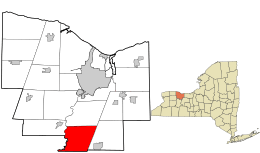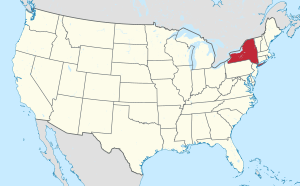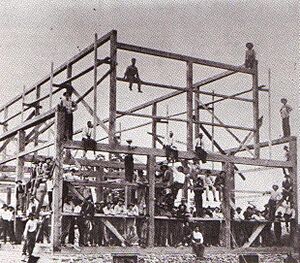Rush, New York facts for kids
Quick facts for kids
Rush
|
|
|---|---|

Location in Monroe County and the state of New York.
|
|

Location of New York in the United States
|
|
| Country | United States |
| State | New York |
| County | Monroe |
| Established | March 13, 1818 |
| Area | |
| • Total | 30.71 sq mi (79.53 km2) |
| • Land | 30.33 sq mi (78.56 km2) |
| • Water | 0.37 sq mi (0.97 km2) |
| Elevation | 579 ft (176 m) |
| Population
(2020)
|
|
| • Total | 3,490 |
| • Estimate
(2016)
|
3,475 |
| • Density | 113.64/sq mi (43.88/km2) |
| Time zone | UTC-5 (EST) |
| • Summer (DST) | UTC-4 (EDT) |
| ZIP code |
14543
|
| Area code(s) | 585 |
| FIPS code | 36-055-64144 |
| Website | www.townofrush.com |
Rush is a small town in Monroe County, New York, United States. In 2020, about 3,490 people lived there. It's a suburb of Rochester, located in the southern part of Monroe County.
Contents
History of Rush
Rush was created in 1818. It was formed from a part of the town of Avon. At that time, it was part of Genesee County. The town might have been named after the plants called "rushes" that grew along the creek. Another idea is that it was named after Dr. Benjamin Rush, one of the Founding Fathers of the United States.
Geography and Nature
Rush is located in a nice area. Its southern and western borders are next to Livingston County. To the north, it borders the town of Henrietta. The town of Wheatland is to its west, and Mendon is to its east. The major highway, Interstate 390, goes through the town.
Honeoye Creek flows through the middle of Rush. This creek has sometimes caused floods. The Lehigh Valley trail follows this creek. It's built on an old railroad line and goes all the way to the Genesee River.
The town of Rush covers about 30.7 square miles (79.5 square kilometers). Most of this area is land, with a small part being water.
People of Rush
| Historical population | |||
|---|---|---|---|
| Census | Pop. | %± | |
| 1820 | 1,701 | — | |
| 1830 | 2,101 | 23.5% | |
| 1840 | 1,929 | −8.2% | |
| 1850 | 2,015 | 4.5% | |
| 1860 | 1,613 | −20.0% | |
| 1870 | 1,654 | 2.5% | |
| 1880 | 1,741 | 5.3% | |
| 1890 | 1,095 | −37.1% | |
| 1900 | 1,491 | 36.2% | |
| 1910 | 2,150 | 44.2% | |
| 1920 | 2,091 | −2.7% | |
| 1930 | 1,901 | −9.1% | |
| 1940 | 1,791 | −5.8% | |
| 1950 | 2,052 | 14.6% | |
| 1960 | 2,555 | 24.5% | |
| 1970 | 3,287 | 28.6% | |
| 1980 | 3,001 | −8.7% | |
| 1990 | 3,217 | 7.2% | |
| 2000 | 3,603 | 12.0% | |
| 2010 | 3,478 | −3.5% | |
| 2016 (est.) | 3,475 | −0.1% | |
| U.S. Decennial Census | |||
In 2000, there were 3,603 people living in Rush. They lived in 1,268 households, and 995 of these were families. Most households were married couples living together. About 32.3% of households had children under 18.
The average household had 2.62 people, and the average family had 2.94 people. The median age in the town was 39 years old. This means half the people were younger than 39, and half were older.
Fun Things to Do in Rush
There are some interesting places to visit in Rush:
- The Rochester & Genesee Valley Railroad Museum is on NY 251 in Industry. It shows off the history of local railroads. You can even take a very short train ride to the New York Museum of Transportation nearby.
- The Lehigh Valley Trail is a popular path. It follows Honeoye Creek where an old railroad used to be. People enjoy walking on it in the summer and cross-country skiing in the winter. Remember, no motorized vehicles are allowed on the trail!
- Rush Veteran's Memorial Park is a great spot for fishing. You can fish both above and below the waterfalls.
- The Rush Creekside Inn is a local landmark. It was built where the old Rush Hotel used to be before it burned down in 1981.
Schools and Learning
Public Schools in Rush
Children in Rush go to public schools managed by the Rush-Henrietta Central School District. This district has five elementary schools, two middle schools, a ninth-grade academy, and one high school, which is Rush–Henrietta Senior High School. Some parts of Rush are also served by the Honeoye Falls-Lima Central School District and Avon Central Schools District.
Rush Public Library
The Rush Public Library has been helping people learn and read since 1914. It's a great place to find books and information.
Famous People from Rush
- George Coe was the 11th Lieutenant Governor of Michigan.
- Mary Galentine Fenner (1839–1903) was a poet and writer.
- Gary Lewis, a well-known singer, lives in Rush.
Places in Rush
Here are some of the smaller communities and areas you can find within the town of Rush:
- Five Point – A small community in the southwest part of town.
- Golah – A community located in the western part of the town.
- Industry – A community found west of North Rush, along Route 251.
- Manns Corner – A community east of North Rush, also on Route 251.
- Meadow Wood – Another community in the southwest part of the town.
- North Rush – A community in the northwest part of the town, on Route 251.
- Rush – This is the main village area, located in the northeast part of the town.
- West Rush – A community in the western part of the town, west of the main highway.
See also
 In Spanish: Rush (Nueva York) para niños
In Spanish: Rush (Nueva York) para niños


